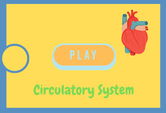Circulatory System Game Quiz Online
This page features a Circulatory System Game Quiz Online. It is an exercise for students studying science in 3rd, 4th, 5th, 6th to 8th grades. Students will learn about human circulatory system. Remember to learn more by readding the article below.

Nothing beats the healthy rush you get after getting some exercise – that feeling when your heart races and you feel your blood pumping. Indeed, your circulatory system – and your heart, especially – works hard to ensure your body continues to operate even when you’re running, lifting weights, or doing sports. How well do you know your own circulatory system?
How the circulatory system works
The circulatory system is also known as the cardiovascular system and pumps blood from the heart to the lungs. The heart then sends oxygenated blood through arteries to the rest of the body. Blood is pushed through the body by the heart. It moves at a high velocity and under high pressure. It travels along the main artery, the aorta. Blood travels in the aorta at approximately 30 cm per second. Blood travels at a slower rate in the arteries, arterioles, capillary beds, and veins. The blood traveling through these pathways carries oxygen and nutrients throughout the body.
- Capillaries
Red blood cells must pass through a collection of tiny vessels called capillaries. Each capillary measures about eight to 10 micrometers across and is made up of two layers of cells called endothelial cells and epithelial cells. These cells create a smooth surface on the inside of the vessel that controls the flow of fluidsuid, gases, and nutrients. Capillaries also contain specialized receptor cells known as microvesicles.
In contrast to larger vessels, capillaries don't have smooth muscle on their own walls. Thus, capillary walls undergo passive changes, which are regulated by signaling molecules from surrounding larger vessels. In addition, arterioles contain small gaps between endothelial cells, which allow gases, water, sugar, and hormones to pass through. Capillaries are also present in the lungs and heart.
Blood is pumped through these vessels, which carry it throughout the body. Arteries carry blood away from the heart and veins return it to the heart. Capillaries transport oxygen and food nutrients from the blood to body tissues and connect the arteries and veins. Unlike arteries, veins have three distinct layers, which are called tunica externa, tunica media, and tunica intima.
- Venules
Venules in the circulatory system are small veins that receive blood from capillaries and exchange oxygen, nutrients, and water products. They are surrounded by post-capillary sphincters. The venules' thin walls make them prone to rupture, allowing excess blood volume to escape into the body. Therefore, it is important to understand their roles in the circulatory system.
The venules contain two distinct layers, the tunica media and tunica adventitia. Each layer is composed of smooth muscle cells and contains a collagenous matrix.
Typically, the tunica media of the venules is composed of two or three layers of collagen, while the tunica adventitia is made of relatively thick fibrous connective tissue. The venous system tends to follow the course of arteries, which is why veins and arteries share similar structures.
The venules in the circulatory system carry blood from the capillaries back to the heart. The small venules are surrounded by rich populations of pericytes, while the large venules have an absence of endothelial junctions. The venules are the most permeable region of the blood system. They also lack the tunica media, and have a collapsed lumina.
- Arteries
Blood vessels are important components of the circulatory system, carrying oxygenated blood away from the heart. However, they are different from veins, such as the umbilical artery. Blood is composed of approximately 92% water, while only a fraction of it reaches the skin. Arteries also function as heat exchangers, transferring heat to organs and tissues. They are about half a millimeter in diameter and are able to stretch and constrict depending on the heart's activity.
Arteries are important to the circulatory system, and each individual artery serves a distinct purpose. Aorta: the largest artery in the body, it is located at the top of the heart. Its primary function is to carry oxygen-rich blood away from the heart and into other organs. Depending on its function, it can be damaged or completely blocked, threatening the body's blood supply. Other arteries: are the pulmonary artery, which supplies blood to the lungs, and the inferior mesenteric artery, which carries blood back to the heart.
The outermost layer of arteries is composed of collagen fibers and elastin. These fibers are controlled by hormones and special signals sent by the nervous system. Arteries have three layers: an outer layer made of collagen fibers, a middle layer of smooth muscle, and an inner lining made of the endothelium. The hollow center of arteries is the pathway for blood and oxygen to travel throughout the body. If the hollow center becomes congested due to plaque, it can raise blood pressure and cause tissue death.
